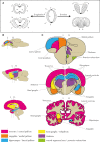The Role of Zebrafish and Laboratory Rodents in Schizophrenia Research
- PMID: 33101067
- PMCID: PMC7500259
- DOI: 10.3389/fpsyt.2020.00703
The Role of Zebrafish and Laboratory Rodents in Schizophrenia Research
Abstract
Schizophrenia is a severe disorder characterized by positive, negative and cognitive symptoms, which are still not fully understood. The development of efficient antipsychotics requires animal models of a strong validity, therefore the aims of the article were to summarize the construct, face and predictive validity of schizophrenia models based on rodents and zebrafish, to compare the advantages and disadvantages of these models, and to propose future directions in schizophrenia modeling and indicate when it is reasonable to combine these models. The advantages of rodent models stem primarily from the high homology between rodent and human physiology, neurochemistry, brain morphology and circuitry. The advantages of zebrafish models stem in the high fecundity, fast development and transparency of the embryo. Disadvantages of both models originate in behavioral repertoires not allowing specific symptoms to be modeled, even when the models are combined. Especially modeling the verbal component of certain positive, negative and cognitive symptoms is currently impossible.
Keywords: animal models; laboratory rodents; model validity; neurobiology; schizophrenia; schizophrenia symptoms; zebrafish.
Copyright © 2020 Langova, Vales, Horka and Horacek.
Figures
Similar articles
-
Developing zebrafish experimental animal models relevant to schizophrenia.Neurosci Biobehav Rev. 2019 Oct;105:126-133. doi: 10.1016/j.neubiorev.2019.07.017. Epub 2019 Jul 29. Neurosci Biobehav Rev. 2019. PMID: 31369798 Review.
-
Cognitive endophenotypes, gene-environment interactions and experience-dependent plasticity in animal models of schizophrenia.Biol Psychol. 2016 Apr;116:82-9. doi: 10.1016/j.biopsycho.2015.11.015. Epub 2015 Dec 10. Biol Psychol. 2016. PMID: 26687973 Review.
-
PCP-induced deficits in murine nest building activity: employment of an ethological rodent behavior to mimic negative-like symptoms of schizophrenia.Behav Brain Res. 2014 Oct 15;273:63-72. doi: 10.1016/j.bbr.2014.07.023. Epub 2014 Jul 24. Behav Brain Res. 2014. PMID: 25064467
-
Color as an important biological variable in zebrafish models: Implications for translational neurobehavioral research.Neurosci Biobehav Rev. 2021 May;124:1-15. doi: 10.1016/j.neubiorev.2020.12.014. Epub 2020 Dec 20. Neurosci Biobehav Rev. 2021. PMID: 33359096 Review.
-
Animal models of schizophrenia.Curr Top Behav Neurosci. 2010;4:391-433. doi: 10.1007/7854_2010_62. Curr Top Behav Neurosci. 2010. PMID: 21312408 Review.
Cited by
-
Advantages and Limitations of Animal Schizophrenia Models.Int J Mol Sci. 2022 May 25;23(11):5968. doi: 10.3390/ijms23115968. Int J Mol Sci. 2022. PMID: 35682647 Free PMC article. Review.
-
Fish as Model Systems to Study Epigenetic Drivers in Human Self-Domestication and Neurodevelopmental Cognitive Disorders.Genes (Basel). 2022 May 31;13(6):987. doi: 10.3390/genes13060987. Genes (Basel). 2022. PMID: 35741749 Free PMC article.
-
Zebrafish, Medaka and Turquoise Killifish for Understanding Human Neurodegenerative/Neurodevelopmental Disorders.Int J Mol Sci. 2022 Jan 26;23(3):1399. doi: 10.3390/ijms23031399. Int J Mol Sci. 2022. PMID: 35163337 Free PMC article. Review.
-
JC-10 probe as a novel method for analyzing the mitochondrial membrane potential and cell stress in whole zebrafish embryos.Toxicol Res (Camb). 2021 Dec 21;11(1):77-87. doi: 10.1093/toxres/tfab114. eCollection 2022 Feb. Toxicol Res (Camb). 2021. PMID: 35237413 Free PMC article.
-
Animal Models of Mitochondrial Diseases Associated with Nuclear Gene Mutations.Acta Naturae. 2023 Oct-Dec;15(4):4-22. doi: 10.32607/actanaturae.25442. Acta Naturae. 2023. PMID: 38234606 Free PMC article.
References
-
- Samões B, Silveira C. The role of vitamin D in the pathophysiology of schizophrenia. Neuropsychiatry (2017) 7:362–9.
-
- Horacek J, Bubenikova-Valesova V, Kopecek M, Palenicek T, Dockery C, Mohr P, et al. Mechanism of action of atypical antipsychotic drugs and the neurobiology of schizophrenia. CNS Drugs (2006) 20:389–409. - PubMed
-
- Aleman A, Kahn RS. Strange feelings: do amygdala abnormalities dysregulate the emotional brain in schizophrenia. Prog Neurobiol (2005) 77:283–98. - PubMed
Publication types
LinkOut - more resources
Full Text Sources


